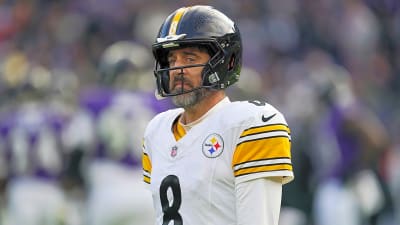- Home
- Quizzes
- My Quiz Activity
- Newsletters
- MY FAVORITES
- Add Sports/Teams
- SPORTS
-
NFL
- NFL Home
- Arizona Cardinals
- Atlanta Falcons
- Baltimore Ravens
- Buffalo Bills
- Carolina Panthers
- Chicago Bears
- Cincinnati Bengals
- Cleveland Browns
- Dallas Cowboys
- Denver Broncos
- Detroit Lions
- Green Bay Packers
- Houston Texans
- Indianapolis Colts
- Jacksonville Jaguars
- Kansas City Chiefs
- Las Vegas Raiders
- Los Angeles Chargers
- Los Angeles Rams
- Miami Dolphins
- Minnesota Vikings
- New England Patriots
- New Orleans Saints
- New York Jets
- New York Giants
- Philadelphia Eagles
- Pittsburgh Steelers
- San Francisco 49ers
- Seattle Seahawks
- Tampa Bay Buccaneers
- Tennessee Titans
- Washington Commanders
-
MLB
- MLB Home
- Athletics
- Arizona Diamondbacks
- Atlanta Braves
- Baltimore Orioles
- Boston Red Sox
- Chicago White Sox
- Chicago Cubs
- Cincinnati Reds
- Cleveland Guardians
- Colorado Rockies
- Detroit Tigers
- Houston Astros
- Kansas City Royals
- Los Angeles Angels
- Los Angeles Dodgers
- Miami Marlins
- Milwaukee Brewers
- Minnesota Twins
- New York Yankees
- New York Mets
- Philadelphia Phillies
- Pittsburgh Pirates
- San Diego Padres
- San Francisco Giants
- Seattle Mariners
- St. Louis Cardinals
- Tampa Bay Rays
- Texas Rangers
- Toronto Blue Jays
- Washington Nationals
-
NBA
- NBA Home
- Atlanta Hawks
- Boston Celtics
- Brooklyn Nets
- Charlotte Hornets
- Chicago Bulls
- Cleveland Cavaliers
- Dallas Mavericks
- Denver Nuggets
- Detroit Pistons
- Golden State Warriors
- Houston Rockets
- Indiana Pacers
- Los Angeles Clippers
- Los Angeles Lakers
- Memphis Grizzlies
- Miami Heat
- Milwaukee Bucks
- Minnesota Timberwolves
- New Orleans Pelicans
- New York Knicks
- Oklahoma City Thunder
- Orlando Magic
- Philadelphia 76ers
- Phoenix Suns
- Portland Trail Blazers
- Sacramento Kings
- San Antonio Spurs
- Toronto Raptors
- Utah Jazz
- Washington Wizards
-
NHL
- NHL Home
- Anaheim Ducks
- Boston Bruins
- Buffalo Sabres
- Calgary Flames
- Carolina Hurricanes
- Chicago Blackhawks
- Colorado Avalanche
- Columbus Blue Jackets
- Dallas Stars
- Detroit Red Wings
- Edmonton Oilers
- Florida Panthers
- Los Angeles Kings
- Minnesota Wild
- Montreal Canadiens
- Nashville Predators
- New Jersey Devils
- New York Islanders
- New York Rangers
- Ottawa Senators
- Philadelphia Flyers
- Pittsburgh Penguins
- San Jose Sharks
- Seattle Kraken
- St. Louis Blues
- Tampa Bay Lightning
- Toronto Maple Leafs
- Utah Mammoth
- Vancouver Canucks
- Vegas Golden Knights
- Washington Capitals
- Winnipeg Jets
- NCAAF
- NCAAM
- Olympics
- Boxing
- Entertainment
- Lifestyle
- Golf
- MMA
- Soccer
- Tennis
- Wrestling
- Sports Betting
- More Sports
- RESOURCES
- My Account
- YB on Facebook
- YB on Twitter
- YB on Flipboard
- Contact Us
- Privacy Policy
- Terms of Service
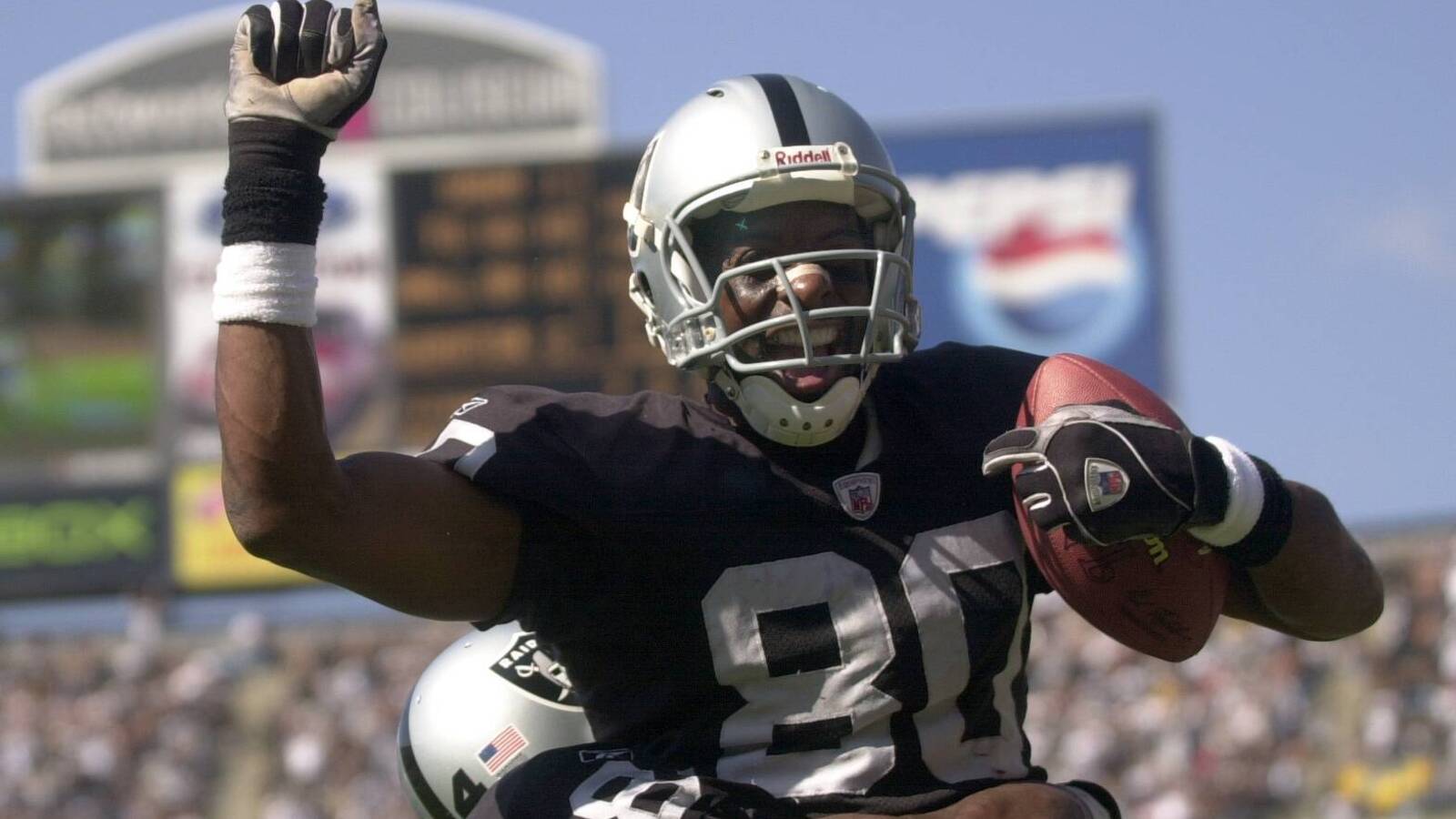
The best bargain signings of the NFL free agency era
The NFL has gone through 31 free agency periods since the player-movement tool began in earnest in 1993. Every team has reaped rewards from correctly identifying a hidden gem or signing a higher-profile player on a team-friendly deal. Here are the best bargain signings of the free agency era. Ranked based on the value of the initial contract and on-field impact, this list only includes offseason signings.
Ben Jones, Tennessee Titans; 2016
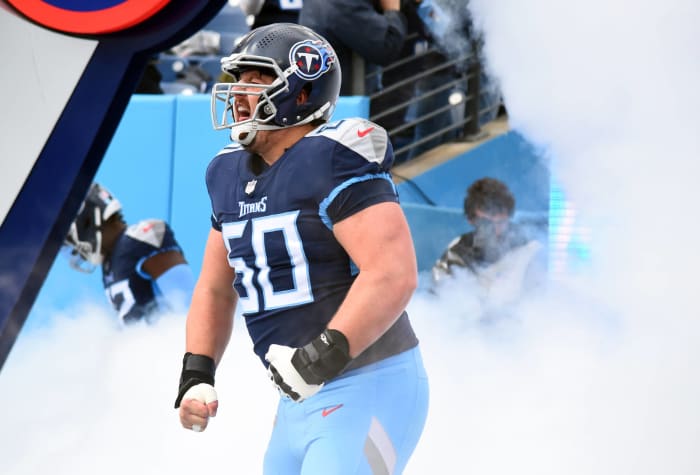
Agreeing to more of a midlevel center contract than a bargain-basement deal, Jones justified Tennessee's investment and became an integral part of the franchise's Mike Vrabel-era spurt. The Titans gave Jones a four-year, $17 million deal to come over from the Texans. That was the first of four agreements between the parties, and Jones made more starts at center (108) than anyone in Titans history. From 2016-21, Jones missed all of one game. The ironman blocker paved lanes for two Derrick Henry rushing titles and helped Ryan Tannehill lead the team on a surprising path to the 2019 AFC championship game.
Baker Mayfield, Tampa Bay Buccaneers; 2023

Needing to stay out more expensive markets like Derek Carr's and (at the time) Jimmy Garoppolo's due to Tom Brady's retirement creating $35 million in dead money, the Bucs gave Mayfield a one-year, $4M deal. This came after Mayfield faceplanted in Carolina. Showing signs of life during a short Rams stint, Mayfield passed on more money for the best chance to start. He beat out former second-round pick Kyle Trask and guided the Bucs to the playoffs. Dispelling fluke notions in 2024, Mayfield bettered his Tampa debut by throwing 41 TD passes despite losing OC Dave Canales. Mayfield played well enough his second Bucs contract (three years, $100M) looks team-friendly.
Desmond Howard, Green Bay Packers; 1996

An underrated NFL superpower, the 1996 Packers enjoyed a lethal luxury -- one that became essential in big moments. After washing out in Washington and Jacksonville, Howard accepted a one-year, $300,000 deal from a Green Bay team that continually failed to vanquish Dallas in the playoffs. The former Heisman winner put together one of the best special teams seasons in NFL history, returning four punts and a kickoff for a touchdown. Two of those jaunts came in the playoffs, with Howard's 99-yard return distancing the Pack from the Patriots in Super Bowl XXXI and earning the return man MVP acclaim. The Raiders signed Howard to a lucrative deal in 1997.
Akiem Hicks, Chicago Bears, 2016

Khalil Mack is most associated with the Bears' late-2010s defensive rise, but the unit began trending upward prior to the sack artist's arrival. A Saints draftee traded to the Patriots in 2015, Hicks inked a two-year, $10 million Bears deal the following spring. In six Chicago seasons, Hicks has become one of the NFL's premier interior defensive linemen. The mammoth inside defender played a vital role in elevating a quarterback-limited team to contention. The Bears have ranked in the top 10 in either total defense or defensive DVOA in four straight seasons during Hicks' run. This period peaked with a No. 1 ranking in 2018; Hicks was a first-team All-Pro that year.
Trent Dilfer, Baltimore Ravens; 2000

Had the Ravens not acquired Dilfer on a one-year, $1 million deal, their relentless defense probably becomes a go-to footnote. A 1999 injury ended Dilfer's underwhelming Buccaneers run, with backup Shaun King leading Tampa Bay to the Super Bowl XXXIV precipice. A two-month backup in Baltimore, Dilfer replaced Tony Banks and led/managed the Ravens to the Super Bowl XXXV championship. The Ravens went 11-1 with Dilfer, who rode shotgun (or perhaps in the backseat by the window) to arguably the greatest defense in modern NFL history. The Ravens did not re-sign him in 2001, bringing about years of QB uncertainty.
Derrick Henry, Baltimore Ravens; 2024

Only the second 1,900-yard runner to fail to make first-team All-Pro (after Ahman Green in 2003), Henry was overshadowed by Saquon Barkley's 2,000-yard year. But the Ravens nabbed Henry on a two-year, $16 million deal that only brought $9M guaranteed. This only surefire Hall of Famer among active RBs -- until goalposts are moved to accommodate the modern RB type -- Henry refused to fall off and gave Lamar Jackson an elite backfield complement. The two-time rushing champ led the NFL with 16 rushing TDs, adding 1,921 yards at age 30. The ageless bulldozer played a big role in Jackson's third first-team All-Pro nod.
Zack Baun, Philadelphia Eagles; 2024

A Saints backup, Baun researched special-teamer contracts as comps before his first crack at free agency. The Eagles signed him on a one-year, $3.5 million deal as a potential rotational edge rusher. Philly gave Devin White more money ($4M). As White never saw the field before being cut, Baun dominated to change his career trajectory. Shifted to off-ball LB to start the season, Baun soared to first-team All-Pro status after becoming the only player in NFL history to post at least 150 tackles and five forced fumbles. Baun carried that momentum to Super Bowl LIX, making a diving interception to ensure viewers needed to prepare for a blowout. The Eagles re-signed him at $17M per year in 2025.
Kyle Vanden Bosch, Tennessee Titans; 2005

A former Cardinals second-round pick, Vanden Bosch saw his value dip after missing the 2003 season with a torn ACL. Following an unremarkable '04 campaign in Arizona, the defensive end signed with the Titans for one year and $540,000. This proved to be a good investment; the pass rusher blossomed in Tennessee. Vanden Bosch ventured to three Pro Bowls in his five-season Titans run. He posted two 12-sack seasons and helped the Titans to back-to-back playoff berths in 2007 and '08. Vanden Bosch's work alongside Albert Haynesworth earned him a four-year, $21M extension.
Mitchell Schwartz, Kansas City Chiefs; 2016
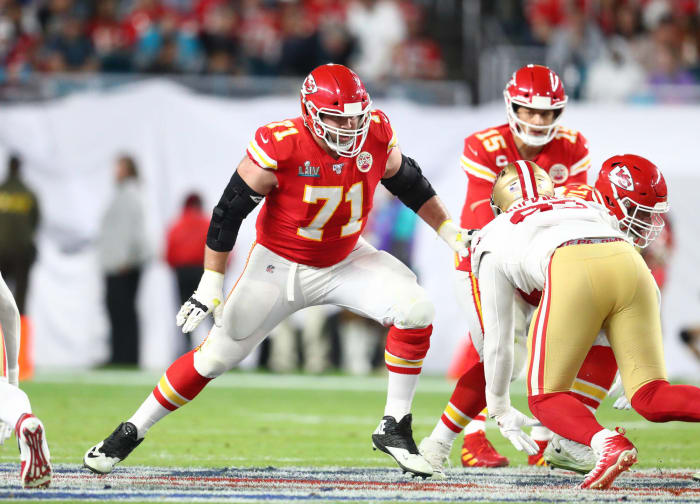
The Chiefs ended their five-year partnership with Schwartz in 2021, making their right tackle a cap casualty. But he solidified himself as one of the NFL's best tackles while in Missouri. The Chiefs signed the ex-Browns iron man to a $6.6M-per-year contract -- a strangely middle-class pact for the younger Schwartz -- and he predictably outplayed it. Schwartz earned first- or second-team All-Pro acclaim (right tackles are usually excluded from Pro Bowls) in his four healthy Chiefs seasons and provided Patrick Mahomes vital protection -- noticeably absent sans Schwartz in a Super Bowl LV blowout loss -- en route to his MVP and Super Bowl MVP honors.
Ryan Clark, Pittsburgh Steelers; 2006

Brought in shortly after the Steelers' fifth championship, Clark helped the team grab Lombardi No. 6 and voyage to another Super Bowl after that. A two-year starter in Washington, Clark committed to Pittsburgh on just a four-year, $7 million accord. He operated as a Steelers starter for the next eight years, joining Troy Polamalu to form a historically sound safety crew. Clark returned from a life-threatening sickle-cell issue in 2008, starting on a No. 1-ranked defense. The future ESPN mainstay forced two turnovers in a Steelers playoff win over the Ravens two years later, helping them to Super Bowl XLV.
Jerry Rice, Oakland Raiders; 2001

Being the greatest wide receiver in NFL history, Rice signed some monster (for the era) 49ers contracts in the 1990s. The 49ers followed through with a long-assured cut in June 2001. Rice joined the Raiders on a four-year, $5.4 million pact, partially due to location, and became another aging piece on a veteran team building toward a Super Bowl run. Rice totaled 2,350 receiving yards and 16 TDs on Oakland's playoff-bound '01 and '02 teams and added three more scores in the playoffs. At 40, Rice made his 13th Pro Bowl and helped Rich Gannon to the 2002 MVP award. Even in the '03 season that saw Gannon go down early, Rice nearly hit 900 yards.
Vinny Testaverde, New York Jets; 1998

The Jets became technically the fourth team to give Testaverde the QB1 reins. The second such club, the Browns, morphed into the third. The Ravens used Testaverde as their starter from 1996-97 but designated him a post-June 1 cut. On June 2, 1998, the Jets gave the former Heisman winner just $1.2 million guaranteed on an incentive-laden deal. The 12th-year veteran's contract carried a team option for a second year. After the former No. 1 overall pick set a Jets record with 29 TD passes and piloted the team to the 1998 AFC title game, New York happily exercised the option. An Achilles tear stalled the Jets in '99, but Testaverde led them back to the playoffs in 2001.
Micah Hyde and Jordan Poyer, Buffalo Bills; 2017

In Sean McDermott's first months with the Bills, the team overhauled its safety corps with two formerly low-key veterans. An ex-Packer, Hyde signed for five years and $30 million; Poyer, previously a Brown, landed in Buffalo on a four-year, $13M pact. They became one of the best safety tandems in modern NFL history, staying together seven seasons. That span coincided with the Bills' pass defense becoming one of the NFL's best and the franchise ending the third-longest postseason drought since the 1970 merger. Pro Football Focus ranked both Poyer and Hyde as top-25 safeties in four straight years, and each earned an All-Pro nod after age 30.
Emmanuel Sanders, Denver Broncos; 2014
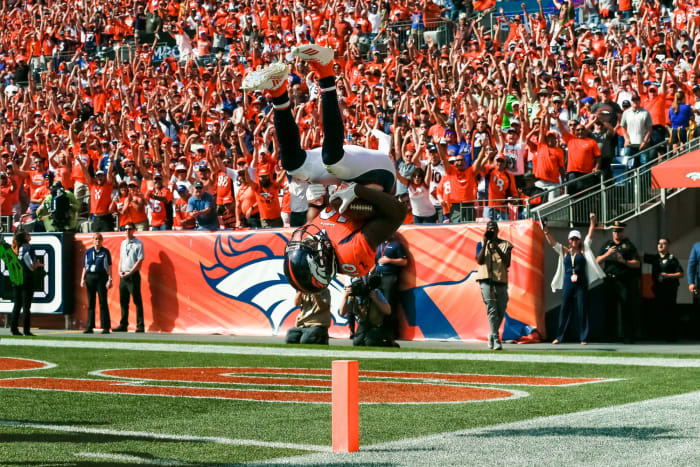
One of the Steelers' many wide receiver finds, Sanders did not bloom until he left Pittsburgh. After backing out of a Chiefs pledge, Sanders trekked to what he then called "wide receiver heaven" with Peyton Manning in Denver. The Broncos landed the future Pro Bowler on a three-year, $15M deal. Sanders did well to help a declining Manning, eclipsing 1,400 yards in 2014 and leading the Broncos in receiving in the '15 playoffs en route to a Super Bowl 50 title. Even as the Broncos descended into QB Hell after Manning's retirement, Sanders dropped his third straight 1,000-yard season in Denver. Sanders played five-plus seasons with the team, being dealt to the 49ers in 2019.
Evan Mathis, Philadelphia Eagles; 2011

A key component in the Bengals' late-2010s decline: letting good O-linemen walk. But prior to Cincinnati allowing Andrew Whitworth and Kevin Zeitler to leave in free agency, the team passed on re-signing a future All-Pro guard. Mathis was a spot starter in Cincinnati, fetching only a one-year, $735,000 Eagles deal. He helped LeSean McCoy to two All-Pro seasons in Philadelphia and stayed for four seasons, earning a more lucrative contract. Pro Football Focus viewed Mathis as an interior-line warlord, and although the Eagles cut him in 2015, Mathis parlayed his mid-career breakout into a spot alongside Sanders with the eventual champion Broncos.
Nick Foles, Philadelphia Eagles; 2017
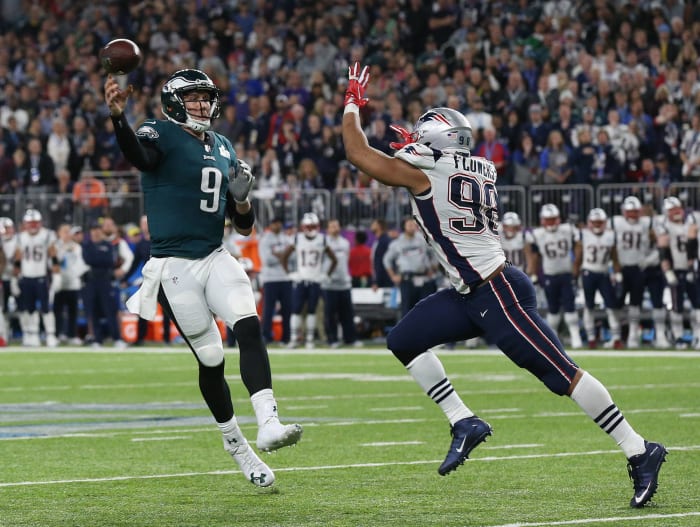
The Eagles gave Foles respectable backup money -- two years, $11 million -- but his work in his first season back in Philly made that contract look team-friendly. Stepping in for an injured Carson Wentz that December, Foles delivered one of the great runs in postseason quarterbacking history and led the Eagles to three upset wins (two of those being upsets because Foles' presence moved point spreads) and the team's first Super Bowl title. Foles was flawless in an RPO-fueled Super Bowl LII MVP outing, catching the most famous pass by a quarterback in the sport's history. He ended up saving the 2018 Eagles' season as well.
Malcolm Jenkins, Philadelphia Eagles; 2014
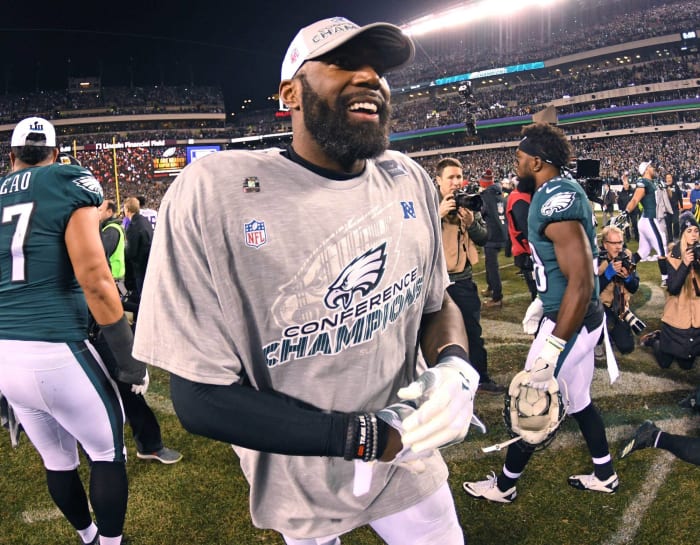
Jenkins stayed for a bit longer than Mathis, becoming a centerpiece player in the Eagles' Super Bowl LII ride. A former Saints first-rounder, Jenkins signed with the Eagles for three years and $15.5 million. Sean Payton expressed regret for letting the talented safety go, and he became a team leader in Philly. Jenkins made three Pro Bowls and helped an Eagles team down would-be MVP Carson Wentz to three upset victories in the 2017 playoffs, securing the franchise its first Super Bowl title. Jenkins stayed six seasons in Philly, moving back to New Orleans in 2020.
Terance Mathis, Atlanta Falcons; 1994

Credit to the Falcons' pro personnel department here. Mathis served as a bit player in four Jets seasons, never eclipsing 400 yards in any of them. The Falcons bought low (two years, $1 million) in the second year of the salary cap era. Mathis erupted for 1,342 yards and 11 TDs in his first Atlanta season, making the Pro Bowl. He played seven more Falcons slates, posting four more 1,000-yard seasons and snaring perhaps the biggest reception in franchise history -- a fourth-down TD grab in the final minute of the 1998 NFC championship game -- to lift Atlanta to its first Super Bowl.
Ed McCaffrey, Denver Broncos; 1995

The cap resided at just $37.1 million in 1995 -- a bit below today's ceiling. But McCaffrey's three-year, $1.5M pact was a bargain then. He stayed with the Broncos for nine seasons and grew from a fringe contributor with the Giants and 49ers to a full-timer for a Broncos team on the cusp of the franchise's apex. McCaffrey collected two Super Bowl rings as Denver's possession target, earning a Pro Bowl nod. Both Rod Smith and his 6-foot-5 wingman reached 100 catches in 2000, two years after John Elway's retirement. Ed returned to his WR2 role in 2002, following a broken leg in '01, before raising Colorado high school prodigy Christian McCaffrey.
Shaq Barrett, Tampa Bay Buccaneers; 2019

Tom Brady's booze-fueled toss of the Vince Lombardi Trophy does not happen without Barrett, who transformed from a backup to an impact sack artist in Tampa. Barrett signed with Tampa Bay on a one-year, $4M deal -- a "prove it" pact for a UDFA who operated as a Von Miller henchman for four years. Barrett smashed Warren Sapp's 20-year-old Bucs franchise record, with 19.5 sacks in 2019. His three drops of Aaron Rodgers helped the Bucs escape Green Bay in the 2020 NFC championship game, opening the door for repeat Barrett chase scenes featuring Patrick Mahomes. Re-signing with the Bucs in 2021, the former Division II recruit has 45 sacks with the team.
Lorenzo Neal, San Diego Chargers; 2003
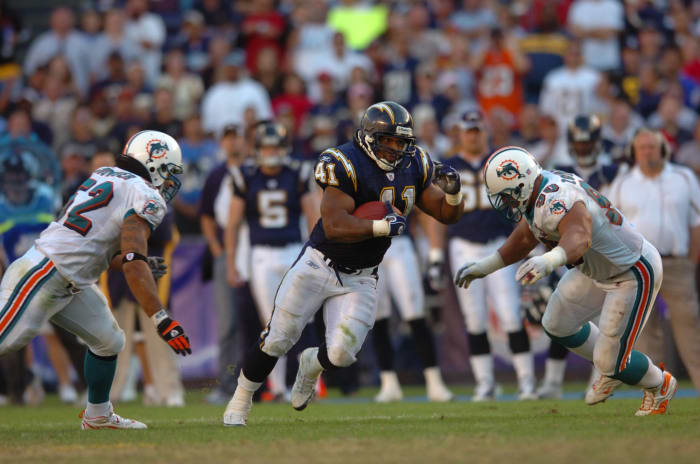
LaDainian Tomlinson showed clear signs of greatness in his first two seasons, but Neal was there for his Hall of Fame-cementing period. The Chargers signed the 11th-year fullback to a three-year, $4.5M contract; Tomlinson reached his scrimmage-yards high (2,370) that year. Neal made the Pro Bowl from 2005-07 and became the oldest skill-position player to be named to the All-Pro first team, at 37. In 2006, Tomlinson obliterated the single-season touchdown record (now 31, a number not threatened since) and won MVP honors on a 14-2 team. Neal played 17 NFL seasons.
Mark Schlereth, Denver Broncos; 1995
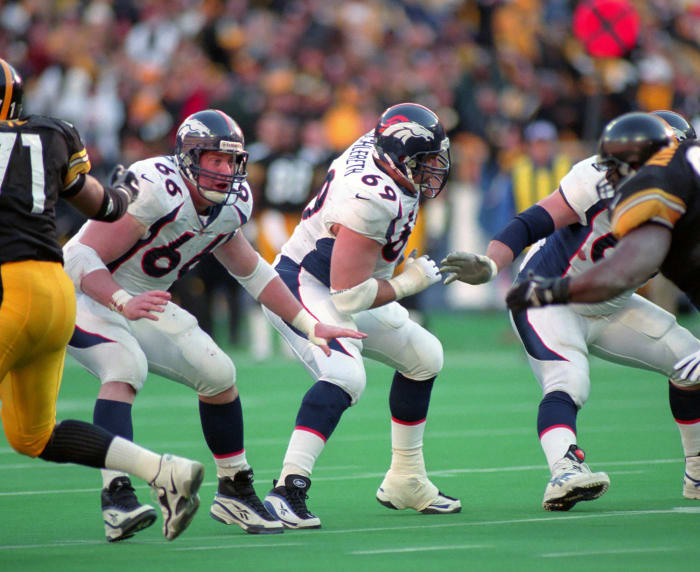
The Broncos' Super Bowl teams featured a host of free agent success stories, from McCaffrey to Bill Romanowski to Neil Smith. Mike Shanahan did well in stocking his late-1990s rosters. Schlereth came over from Washington on a three-year, $2.4 million deal and boosted the Broncos' run-game mastery. Schlereth's Denver debut coincided with Terrell Davis', and after the sixth-round pick's MVP season and the Broncos' two Super Bowl titles, Schlereth helped clear holes for injury replacements Olandis Gary and Mike Anderson during one of the great O-line stretches in NFL history. The future FOX analyst played six seasons in Denver.
Shaun O'Hara, New York Giants; 2004
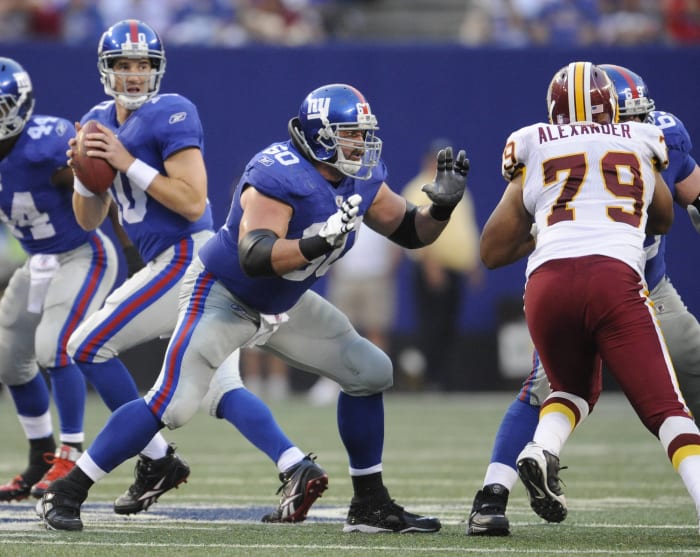
A month before the Giants traded for Eli Manning, they equipped him with a free agent center. O'Hara, who played guard in Cleveland, signed with New York on a three-year, $5.4 million contract. He served as Manning's center for seven seasons, being the pivotman on a few well-assembled Giants offensive lines. O'Hara helped Tiki Barber to two dominant seasons to end his career and became a Pro Bowl mainstay in his 30s, also aiding Barber successors Brandon Jacobs and Derrick Ward to a 1,000-1,000 season in 2008. In between, O'Hara collected a Super Bowl ring and thwarted multiple Patriot rushers on a notable February play.
Joe Horn, New Orleans Saints; 2000
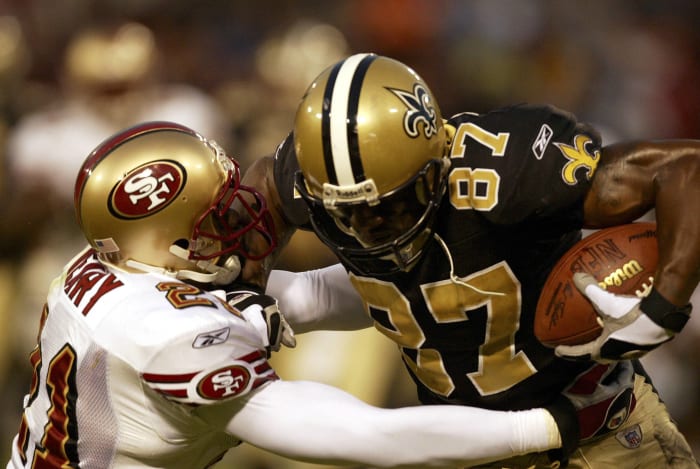
Horn did not need Drew Brees throwing him passes to flood the top of the Saints' receiving record book. He got by with Aaron Brooks, morphing from backup Chiefs wideout to alpha of the Saints' passing attack. New Orleans gave Horn a four-year, $9.9 million deal to poach him from Kansas City, which saw its receiver room endure a tough break when Round 1 pick Sylvester Morris suffered a career-ending injury months after Horn's exit. Horn made four Pro Bowls in seven Saints seasons and was one of the NFC's premier receivers into the mid-2000s. He played just one season with Brees.
Jake Delhomme, Carolina Panthers; 2003

The Panthers changed their fortunes by signing Delhomme 18 years ago. Carolina landed Delhomme, an ex-Brooks backup in New Orleans, on a two-year, $4 million deal. In Year 1, Delhomme quarterbacked the Panthers to Super Bowl XXXVIII. The former UDFA went punch for punch with Tom Brady. Delhomme threw 29 TD passes in 2004, largely without Steve Smith, then made the Pro Bowl in '05 by turning Smith into a monster that powered Carolina to another NFC title game. Delhomme did throw five INTs in his next playoff outing (2008), leading to the end of his Carolina run, but he was undeniably a free agency success story.
Garrison Hearst, San Francisco 49ers; 1997
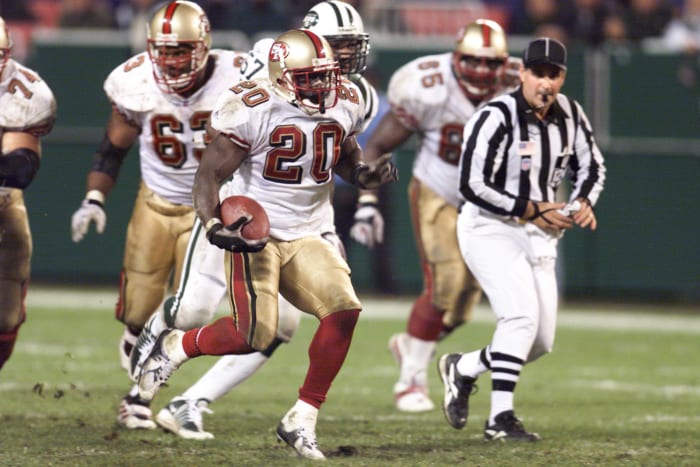
Similar to Leonard Fournette 24 years later, Hearst was a top-five pick waived by a struggling team just before a season. Prior to Hearst's two-year, $2.8 million 49ers pledge, the Bengals claimed the ex-Cardinal running back off waivers in 1996. He soon upgraded in team quality, becoming a featured back for the 49ers' final Steve Young-piloted offenses. Hearst cleared 1,000 rushing yards thrice in San Francisco and authored a unique career arc. He suffered a severe ankle injury that sidelined him in 1999 and 2000 but returned in 2001, winning Comeback Player of the Year honors. Hearst was a 49er until 2003.
Michael Bennett, Seattle Seahawks; 2013
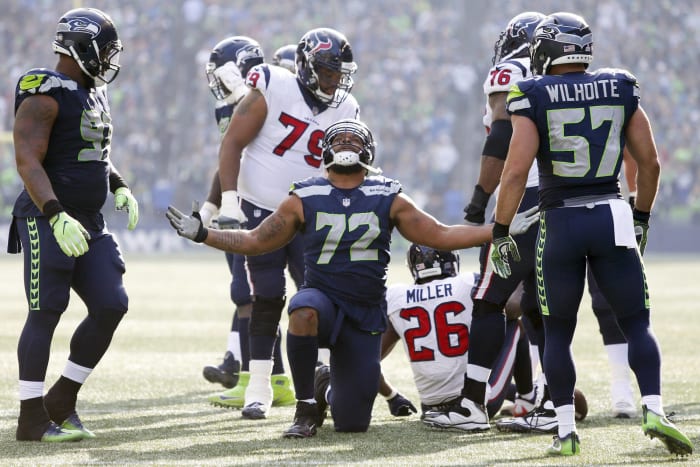
Bennett played so well on the one-year, $5 million contract the Seahawks initially gave him that he earned two more deals before his Seattle stay wrapped. One of the NFL's most versatile defensive linemen of the 2010s, Bennett came over after an anonymous Buccaneers stay. In his first two Seattle seasons, the Seahawks booked Super Bowl trips. Bothering not with appropriately sized shoulder pads, Bennett operated as both a quality edge presence and a dominant interior rusher. The three-time Pro Bowler stayed in Seattle for five seasons, teaming largely with fellow 2013 signee Cliff Avril on loaded defenses, before being traded.
Rod Woodson, Baltimore Ravens; 1998

The Steelers regretted missing out on Woodson's quality back nine, and the 49ers only gave him one season. After San Francisco made Woodson a 1997 cap casualty, he signed with the Ravens on a three-year deal worth just $5.7 million. Still a cornerback in Year 1 of his Baltimore stay, Woodson shifted to safety after the Ravens took Chris McAllister in the 1999 first round. It remains a historically successful position switch. Woodson led the NFL with seven INTs in his first safety season and manned deep patrol for the Ravens' 2000 Super Bowl unit. He made three Pro Bowls in four Baltimore seasons.
Rodney Harrison, New England Patriots; 2003
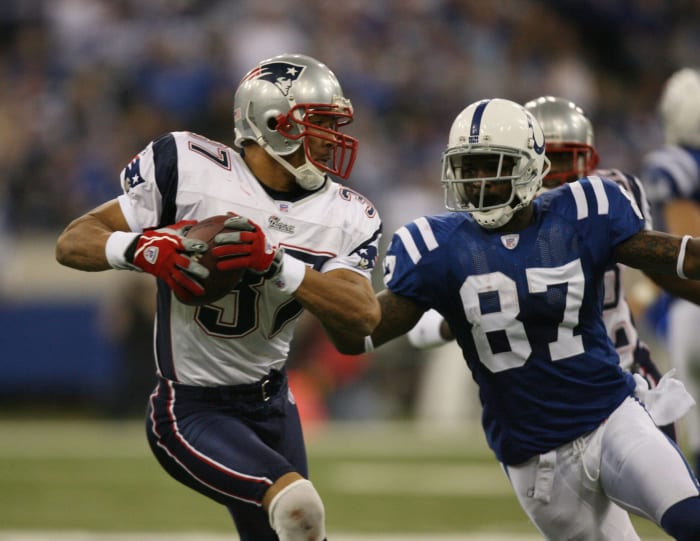
The 21st century's most reliable defense used Harrison as a chess piece for six seasons. Harrison joined the Patriots, spurning interest from the Raiders and a $4 million-per-year offer from the Broncos, who then turned to John Lynch a year later. The Pats signed Harrison to a six-year, $14.9M contract and won the next two Super Bowls. Their controversial enforcer joined Ty Law in a loaded secondary that helped the Pats to first- and second-place defensive rankings in those seasons. The ex-Charger intercepted four passes in the '04 playoffs and managed to play effectively through his age-36 season in 2008.
Mike Vrabel, New England Patriots; 2001
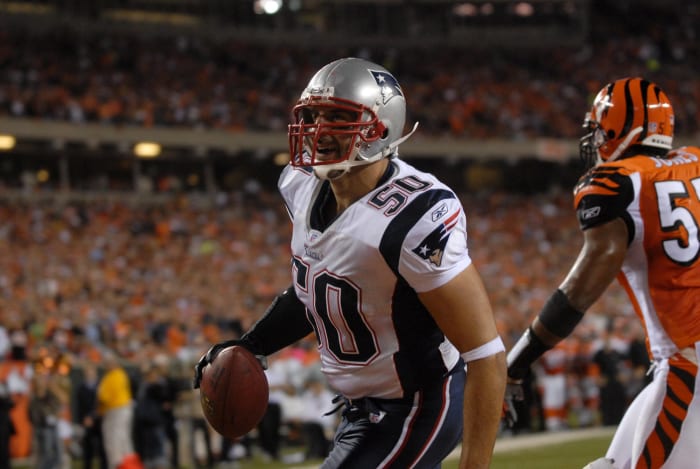
The Patriots supplemented Tom Brady with one of the great free agent classes in history. Running back Antowain Smith, wideout David Patten and defenders Anthony Pleasant and Roman Phifer occupy the "best of the rest" sector of a Vrabel-headlined list. Like the others, Vrabel was a low-cost addition. He outlasted fellow new arrivals by a considerable margin, playing eight seasons with the Pats. The versatile linebacker/goal-line TD magnet played effectively on and off the ball, recording 48 sacks as a Patriot and forcing 19 fumbles. The ex-Steelers backup/future Titans coach played in four Super Bowls.
James Farrior, Pittsburgh Steelers; 2002
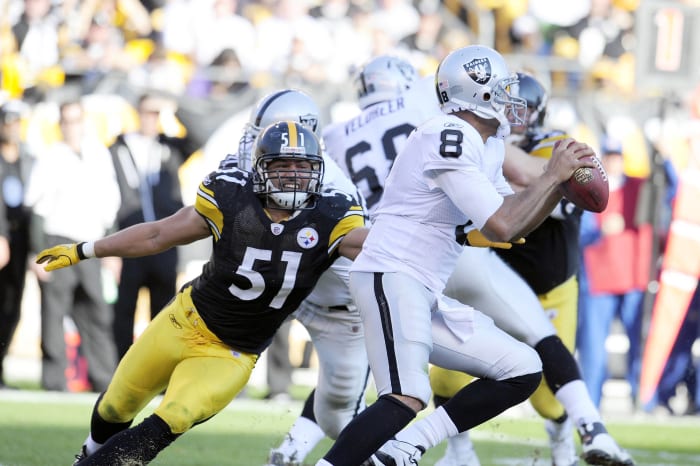
It took the Steelers many years to rebuild their defense after the likes of Farrior, Casey Hampton, Ryan Clark, and Troy Polamalu departed in a three-offseason span. Farrior served as a glue player, anchoring Pittsburgh's linebacking corps as several edge rushers -- from Jason Gildon to Joey Porter to James Harrison to LaMarr Woodley -- passed through. Farrior's Steelers career began with a three-year, $5.4M pact. The former Jet part-timer started for 10 seasons -- mostly on top-tier defenses. The former No. 8 overall pick remained a full-time starter until age 36; no other Steeler defender this century holds that distinction.
Priest Holmes, Kansas City Chiefs; 2001
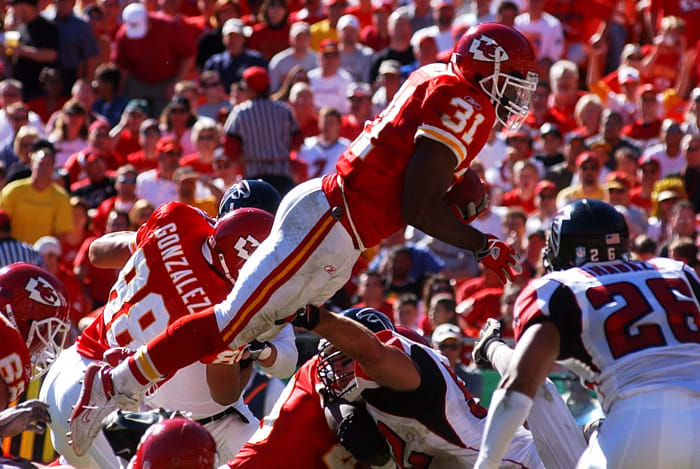
For sheer production out of free agency (non-Brees/Manning division), the Chiefs found a hidden superstar. The Ravens taking Jamal Lewis in the 2000 first round ended Holmes' middling Baltimore stint; he signed a five-year, $8.4 million Chiefs contract. From 2001-03, Holmes totaled 6,566 scrimmage yards and 61 touchdowns. He led the NFL in scrimmage yards in 2002 in just 14 games, with an injury halting a likely record. The Chiefs assembled an all-time offensive line, igniting Holmes. Injuries brought down their star back beginning in 2004. While Tony Gonzalez was also in Kansas City during this time, Holmes catalyzed these elite offenses.
Deion Sanders, San Francisco 49ers; 1994

The same year Sanders signed with the 49ers, his "Must Be the Money" track dropped. However, the iconic cornerback did not require a tremendous amount of dough to sign. The former Falcons icon inked a one-year, $1.13 million pact to switch NFC West uniforms. The 49ers came away with a historic free-agent haul in '94; Ken Norton Jr., Rickey Jackson, Gary Plummer, and Bart Oates were also part of the Sanders-anchored contingent. The Hall of Famer's six-INT, three-pick-six season made a seismic difference in the 49ers overtaking the Cowboys and winning Super Bowl XXIX. Primetime lived up to his lyrics in '95, signing a seven-year, $35M Cowboys deal.
Kurt Warner, Arizona Cardinals; 2005

After Jake Plummer left the desert for Denver in 2003, Jeff Blake and Josh McCown floundered in his place. In 2004, Warner provided the bridge from Kerry Collins to Eli Manning in New York. The Giants benched the two-time MVP after he had them at 5-4. This opened the door to Warner accepting a one-year, $4 million Cardinals offer. He quickly thwarted Matt Leinart's takeover attempt and reminded the football world of his Rams brilliance, throwing 83 TD passes from 2007-09. Narrowly losing Super Bowl XLIII, Warner still delivered one of the best late-30s stretches in NFL history. It doubled as the best Cards run in 60 years.
Keenan McCardell and Jimmy Smith, Jacksonville Jaguars; 1995-96
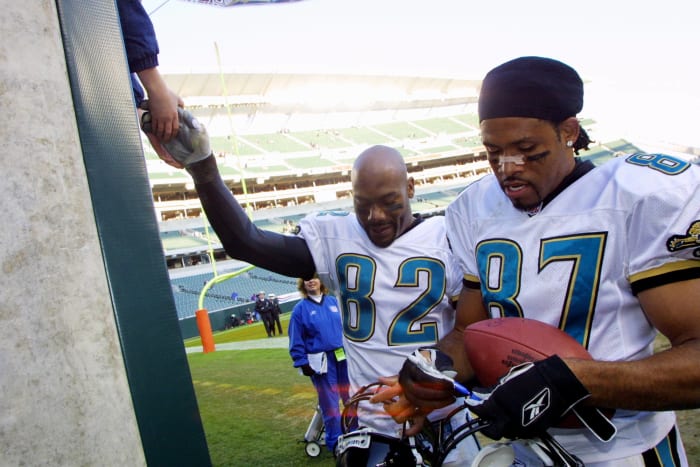
A bit of cheating, yes, but these two are interlocked and have similar Jaguars origin stories. A former Cowboys Round 2 pick, Smith caught on with the Jags in 1995 on a low-end deal. McCardell, an ex-Browns auxiliary wideout, joined him a year later. No Jaguar receiving tandem has approached their work, and their first four seasons together produced six 1,000-yard campaigns between them and four Jacksonville playoff berths. Both landed higher-paying extensions, but the Jags capitalized on the exclusive negotiating rights that came with signing the duo in the mid-'90s. The partnership lasted six years.
Sam Robinson is a sportswriter from Kansas City, Missouri. He primarily covers the NFL for Yardbarker. Moving from wildly injury-prone sprinter in the aughts to reporter in the 2010s, Sam set up camp in three time zones covering everything from high school water polo to Division II national championship games
More must-reads:
- Possible Philip Rivers-Colts reunion is a wild, terrible idea
- Browns turn to Shedeur Sanders as full-time starter, signal future direction
- The '2K-scrimmage-yard NFL seasons' quiz
Breaking News
Trending News
Customize Your Newsletter
 +
+
Get the latest news and rumors, customized to your favorite sports and teams. Emailed daily. Always free!
PRIVACY POLICY EDITORIAL POLICY CONTACT US
ABOUT YARDBARKER TERMS OF SERVICE
Use of this website (including any and all parts and
components) constitutes your acceptance of these
Terms of Service and Privacy Policy.
This site is for entertainment purposes only.
There is no gambling offered on this site.
Gambling Problem? Call 1-800-Gambler.



